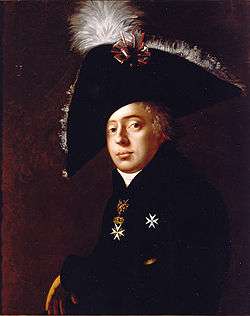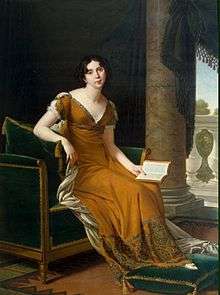Nikolai Nikitich Demidov
Count Nikolai Nikitich Demidov (9 October / November 1773, Chirkovitsy, Saint Petersburg Governorate – 22 April 1828, Florence) was a Russian industrialist, collector and arts patron of the Demidov family.

Life

The son of Nikita Akinfiyevich Demidov (1724-1786) and his third wife Alexandra Safonova, Nikolai Demidov inherited his father's industrial empire aged only 15 and began to spend so recklessly that the government had to send in the receivers. In September 1795 at Saint Petersburg he married Baroness Elisabeta Alexandrovna Stroganova (5 February 1779 - Paris, 27 March 1818). They had four children - Aleksandra Nikolaievna Demidova (19 October 1796 - 24 August 1800), Pavel Nikolaievich Demidov (1798-1840), Nikolai Nikolaievich Demidov (17 February 1799 - 24 August 1800) and Anatoly Nikolaievich Demidov, 1st Prince of San Donato (1812-1869).
Nikolai entered the diplomatic service and the young couple moved to Paris, becoming ardent supporters of Napoleon I of France and setting up home in the hôtel de Brancas-Lauragais, at the corner of rue Taitbout and boulevard des Italiens. However, rising Franco-Russian tensions forced his recall and they moved back to Russia via Italy, arriving in Russia in 1812. He fought with distinction in the Russo-Turkish War (1806-1812) and at the start of the French invasion of Russia he financed the creation of an infantry regiment (including his son Pavel as one of its officers, which he then commanded against Napoleon's forces, fighting at Oravais and Borodino.
In 1813 he gave his important collections to the mineralogical museum of Moscow (founded by his uncle Pavel Grigoryevich) to replace those lost in the burning of the city, giving art to Moscow University in the same vein. He also financed the construction of 4 bridges in Saint Petersburg. With age, he also became a wiser industrialist, modernising his factories' infrastructure and doubling his fortune. He gave his home over to many industries and public utility services, perfecting the exploitation of mines and raising his income to 5 million. He also acclimatised Bordeaux and Champagne vines and Lucca olive trees to the Crimea.
Nikolai Demidov served as chamberlain to the Tsar, a Hereditary Commander of the Order of Saint John of Jerusalem, and member of the privy council.
In 1819 he was made Russian ambassador to the court of Tuscany. After divorcing his wife, who moved back to France, he lived his last years in France and Italy among scholars, financing the creation of schools, hospitals and other charitable institutions in Tuscany. He bought 42 acres (170,000 m2) of marshland north of Florence from the Catholic Church and there built the Villa San Donato from 1827 to 1831 (now destroyed), where he set up richly-decorated private rooms, a suite of 14 rooms housing his enormous art collection, a theatre and a foreign languages academy. That collection, reputed among the most lavish private collections in Europe, was divided between his residences in San Donato, Saint-Petersburg, Paris and Moscow, included works by Flemish and Italian masters, decorative art objects and a famous collection of weapons now in the Wallace Collection in London. His collection of ancient Greek and Roman sculptures is now at the Hermitage Museum. By decree of Leopold II, Grand Duke of Tuscany, on 23 February 1827 Demidov was made "count of San Donato" for the services he had rendered to Tuscany by setting up a silk factory.
A public Monument to Nicola Demidoff designed by Lorenzo Bartolini is located on "Piazza Demidoff" overlooking the river Arno in Oltrarno.